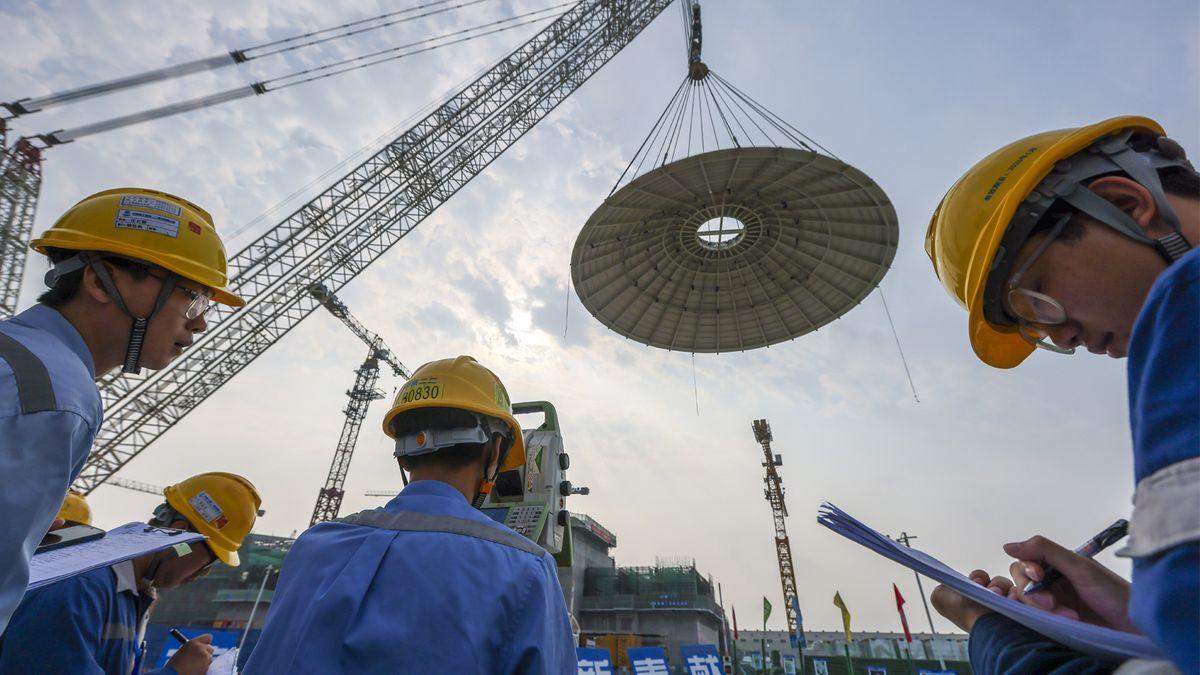Small Nuclear Reactors: A Gamble to Power AI's Surging Energy Demands
3 Sources
3 Sources
[1]
Data centers to account for 9% of electricity demand in the U.S by 2035, an increase of 5% -- Nuclear power could help sate AI demand
Regulatory approval and standardization could take years to get them off the ground, though. Alongside questions of how the major AI tech firms are going to afford the AI-revolution they're all driving us towards, others remain over how they're going to power it. With 9% of the entire US electricity demand expected to come from data centers by 2035, according to Bloomberg, Google, Amazon, Oracle, and others are pursuing investments in small, modular nuclear reactors as potential solutions for on-site power without the intermittent service downsides of renewable energy. In 2024, Google struck a deal with Kairos Power to help build out 500 megawatts of small nuclear reactors by the mid-2030s. Equinix has also struck a deal with small reactor developer Oklo -- a firm backed by OpenAI's Sam Altman -- to build out 20 micro reactors, and that could just be the start. Over the past year, we've seen a flurry of announcements around enormous investments in data center creation, the buildup of "AI factories, " and huge global plans for building infrastructure to power a bevy of new AI technologies. In short, major tech companies are building data centers to house hundreds of thousands of CPUs and graphics cards, for AI usage as they look to integrate the technology into governments, the military, and everyday life for consumers. But with individual graphics cards requiring upwards of 500W of power, there are frank discussions taking place over where all the extra electricity for these projects is going to come from. In June this year, EpochAI published a study which showed that the most capable AI supercomputing systems were pulling more power with each iteration, and doubling those needs every couple of years. Elon Musk's xAI Colossus supercomputer requires over 280 Megawatts - 20 times the power needed for the top AI data center in 2019, according to the study. Even in that single location, hunger for more power is seemingly never-ending. In September, we reported that through the deployment of mobile gas turbines at the Memphis site, xAI's Colossus was now generating close to 500MW of power - all while sidestepping regulations. This puts it halfway to its plans to reach one gigawatt of electricity generation on site in the future. That's just one of many projects at many companies and highlights the sheer scale of the potential power problem facing technology firms wanting to rapidly build out the AI infrastructure they're all so desperate to invest in. One of the ways they may be able to manage this long-term is through small, modular nuclear reactors. The clue with small, modular nuclear reactors (SMR) is very much in the name. They are physically smaller, requiring less infrastructure than their more traditional counterparts, and have lower operating capacity. Where a standard reactor might start at 1,000 megawatts and go from there, SMRs are typically in the 300-500 megawatt range, and can be as small as a quarter the size of their traditional counterparts. This might not seem like a huge innovation, but it's often the scale of nuclear plants and their associated requirements that make them so hard to build. By focusing on smaller designs, they can be built closer to where the power is needed, reducing the costs of associated power transmission infrastructure. Assuming they have access to the water and other resources needed, they could even help power off-grid and remote locations like mines, and indeed, data centers. Their modular designs also make construction simpler, with many of their components built off-site and then assembled on-site. This streamlines, cheapens, and shortens construction times, which can extend into the decades for more traditional reactors. As Bloomberg highlights, the Vogtle 3 and Vogtle 4 traditional reactors built in Georgia took over seven years longer than intended to build and ended up costing twice their projected $14 billion price tag. Outside the U.S., other governments and entities are also banking on SMRs to power much of the AI revolution into the future. During a recent trip to the UK by President Trump, alongside a number of high-profile data center and tech deals, a key announcement was a collaborative effort between US and UK companies to further develop SMR technology with Rolls-Royce. The UK is also investing £2.5 billion($3.4 billion) in SMRs over the next decade, though the first reactor won't come online until the mid-2030s. France's state-owned Electricité de France SA is investing in the Nuward SMR project, and a number of US firms backed by Bill Gates and other tech entrepreneurs are developing SMRs in America. The first SMRs to come online were operated by Russia's Rosatom Corp and China's China National Nuclear Corp. They launched 35-megawatt and 100-megawatt reactors earlier this decade. All the announcements and technology investments are encouraging for those concerned about the scale of power demand from these new data centers, but there is the ongoing issue with the time it takes to bring these facilities online. Although SMRs are designed to be built faster and with fewer local regulation hurdles to clear, they are still mired in red tape and paperwork. Although there are over 100 SMR designs currently going through the approval process, none of them have completed it to date. One 77-megawatt reactor design from Nuscale has been approved, but its project was cancelled in 2023 due to rising potential costs of the electricity it would produce. That came after over three years and $500 million spent as part of the approval process. Even with the Trump administration promising a quadrupling of US nuclear power by 2050, and plans from the US Department of Energy to invest billions in small nuclear projects, it's still unclear how fast the approval process can be made, when it's such a complicated one. As it stands, there are significant hurdles for anyone looking to build out these designs. Although the cost of production is less impactful if it's powering a profit-making AI factory, there's no guarantee that it will be financially viable in the years to come. But AI is going to need power, regardless of what job it ends up doing, and renewables are unlikely to be able to offer the full scale of power generation required. Although battery technology could allow for intermittent supply issues to be mitigated, most of these locations will require main grid access to ensure a consistent electricity supply. SMRs offer an intriguing alternative and seem likely to form part of the future backbone of US power generation, but it's going to take a lot of time to get them off the ground. That then returns to the question of how these major tech companies are going to power all their new projects. If the xAI approach is anything to go by, it'll likely involve a lot of mobile, localised gas turbines, at least for the foreseeable future.
[2]
Can Small Nuclear Reactors Help Power the AI Boom and Fight Climate Change?
Much of the world had been turning away from traditional nuclear power in recent decades. Aging plants, high construction costs, security risks and radioactive-waste challenges caused policymakers and the public to question the economics of atomic energy. Interest in the technology has only recently been revived amid pressure to hit climate goals and meet surging electricity demand. The proliferation of data centers, in particular, has focused attention on the availability of around-the-clock power needed by the server farms that underpin the digitized economy and are the backbone of artificial intelligence.
[3]
US and investors gambling on unproven nuclear technology, warn experts
The US government and investors have made a $9bn gamble on small nuclear reactors to power the AI boom and lower emissions -- but experts warn the technology could prove too costly to be viable. Data compiled by the FT shows that since 2019, government agencies including the energy and defence departments have committed over $6bn to developers of small modular reactors (SMRs) through awards, loans and cost sharing agreements. Private investment has also soared, with over $3bn raised in the same timeframe. The technology promises a one-stop solution to data centres' power needs by providing clean, reliable and cheap electricity for companies to train and run their AI models. Investor enthusiasm has lifted the share prices and valuations of companies with little or no revenues or operating projects. "There's a lot of cheerleading happening, but the amount of capital that you need to cross the finish line is huge," said Chris Gadomski, head of nuclear research at BloombergNEF, which estimates data centre power needs will more than double by 2035. "What I see happening with SMRs and data centres reminds me of the internet boom and bust of the early 2000s." Small modular reactors generate up to 300 megawatts of power each -- a fraction of the roughly 1,000 megawatts produced by reactors at utility plants like Georgia's Vogtle, the largest in the country. But questions linger over whether the technology can produce electricity which is cost competitive with bigger nuclear plants, renewables and natural gas. Past efforts to build SMR projects in the US have been plagued by delays and cost overruns. In 2023, NuScale -- which has a design approved by US regulators -- was forced to cancel a project after costs ballooned more than 120 per cent. The three operating SMRs worldwide, which are located in Russia and China, exceeded their original cost estimates by 300 to 400 per cent. Estimates of SMR's "levelised cost of energy" -- power cost that should be charged for the project to break even -- produced by independent analysts and the companies themselves vary significantly. According to data from Wood Mackenzie, by 2030 SMRs should generate power at $182 per megawatt hour compared with $133 per megawatt hour for conventional nuclear. Natural gas is expected to sit at $126 per megawatt hour, while onshore wind and solar, backed up by battery, are projected to be around one-third less expensive. According to Oklo, the SMR developer backed by Sam Altman and energy secretary Chris Wright, its technology will generate power for $90 per megawatt hour, while NuScale says its power cost is $64 per megawatt hour. Some nuclear engineers say larger reactors are cheaper to build, citing the greater need for steel, concrete, safety systems, cooling pipes and sensors required for multiple smaller units. "There are many companies that think if they go Henry Ford and build an assembly line, everything will be cheap," said Nick Touran, a nuclear engineer and consultant. "There are massive economies of scale that they're neglecting." Supply chain bottlenecks also weigh heavily on reactor costs. Most SMRs are designed to use high-assay low-enriched uranium, a denser fuel than what is used in larger reactors. Since its production is dominated by Russia and there is only one plant in the US licensed to produce at scale, companies are reliant on government stockpiles. "We need the supply chain to be built out," said Dimple Gosai, head of US cleantech and sustainability equity research at Bank of America, who estimates that elevated fuel costs could add up to $20 per megawatt hour to developers' power costs. However, advocates say the cost of SMRs will track downwards over time. "Any first plant will have challenging economics," said Simon Irish, chief executive of Terrestrial Energy, which says its power cost is $69 per megawatt hour. "But from there we roll downhill." Valar Atomics founder and chief executive, Isaiah Taylor, said SMRs' lower safety requirements enable cost savings. "If you start small, you have intrinsic safety, which you can use to make it simpler and deploy a lot faster," he said. Others point out that although its supply is stretched, uranium prices are less volatile than natural gas. "You get a more stable and predictable 60-year price on a nuclear plant," said X-energy chief executive J Clay Sell. SMR companies are increasingly signing power supply deals with utilities and tech companies, with over 32 gigawatts of commitments since 2023. Some deals, such as one between Google and Kairos, a reactor developer, for the latter to provide 500 megawatts by 2035, are binding agreements, but most are exploratory agreements. Still, even nonbinding deals are a "significant step forward", says David Brown, director of Wood Mackenzie's Energy Transition Practice, since investors are warier of nuclear than other technologies and offer developers higher interest rates. "It's a big vote of confidence in the sector and shows there's a path to commercial viability."
Share
Share
Copy Link
Tech giants and investors are betting on small modular reactors (SMRs) to meet the growing electricity demands of AI-driven data centers. However, experts warn of potential economic challenges and unproven technology.
The AI Power Crunch and the Nuclear Solution
As artificial intelligence (AI) continues to revolutionize various sectors, the technology's voracious appetite for electricity is becoming increasingly apparent. Data centers, the backbone of AI infrastructure, are projected to account for 9% of the entire U.S. electricity demand by 2035, marking a significant 5% increase from current levels
1
. This surge in power demand has led tech giants and investors to explore innovative solutions, with small modular reactors (SMRs) emerging as a potential answer.
Source: Bloomberg
The Rise of Small Modular Reactors
SMRs are compact nuclear reactors designed to generate between 300-500 megawatts of power, significantly smaller than traditional reactors that typically start at 1,000 megawatts
1
. Their modular design allows for easier construction, potentially reducing costs and build times compared to conventional nuclear plants. Tech companies are showing keen interest in this technology, with Google partnering with Kairos Power to develop 500 megawatts of small nuclear reactors by the mid-2030s, and Equinix collaborating with Oklo, backed by OpenAI's Sam Altman1
.
Source: FT
Global Interest and Investment
The enthusiasm for SMRs extends beyond the United States. The UK government is investing £2.5 billion ($3.4 billion) in SMR development over the next decade, while France's state-owned Electricité de France SA is backing the Nuward SMR project
1
. Russia and China have already launched operational SMRs, with capacities of 35 and 100 megawatts, respectively1
.Economic Viability and Challenges
Despite the growing interest, experts warn that the economic viability of SMRs remains uncertain. The technology has attracted over $9 billion in investments since 2019, with the U.S. government committing more than $6 billion and private investors contributing over $3 billion
3
. However, past SMR projects have faced significant delays and cost overruns, raising concerns about their competitiveness with other power sources.
Source: Tom's Hardware
Cost Comparisons and Skepticism
Estimates of SMRs' levelized cost of energy vary widely. Wood Mackenzie projects that by 2030, SMRs could generate power at $182 per megawatt-hour, compared to $133 for conventional nuclear and $126 for natural gas
3
. Some SMR developers claim much lower costs, with Oklo and NuScale projecting $90 and $64 per megawatt-hour, respectively3
. However, nuclear engineers argue that larger reactors may be more cost-effective due to economies of scale.Related Stories
Supply Chain and Fuel Concerns
The SMR industry faces additional challenges related to fuel supply. Most SMRs are designed to use high-assay low-enriched uranium, which is primarily produced in Russia. With limited production capacity in the U.S., companies may need to rely on government stockpiles, potentially adding up to $20 per megawatt-hour to power costs
3
.The Path Forward
Despite the challenges, proponents of SMRs remain optimistic about the technology's potential to provide clean, reliable power for AI data centers and contribute to climate change mitigation efforts
2
. As the AI boom continues to drive electricity demand, the success of SMRs could play a crucial role in shaping the future of both the tech and energy sectors.References
Summarized by
Navi
[1]
Related Stories
Big Tech's Nuclear Pivot: Powering AI Ambitions with Atomic Energy
15 Oct 2024•Technology

Tech Giants Embrace Nuclear Power to Fuel AI's Energy Demands
22 Oct 2024•Business and Economy

Google Explores Nuclear Power for AI Data Centers: Balancing Energy Demands with Climate Goals
04 Oct 2024•Business and Economy








